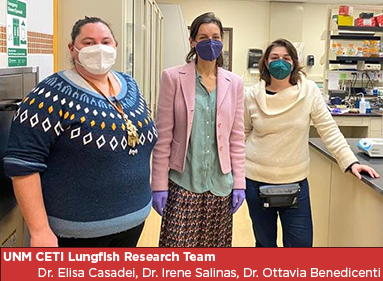CARC enables groundbreaking immunology discovery
By Melanie Furber Fudge
Associate Professor of Biology at the University of New Mexico’s Center for Evolutionary and Theoretical Immunology (CETI) Irene Salinas and one of her research teams recently published “ The lungfish cocoon is a living tissue with antimicrobial functions” in ScienceAdvances. The article details the remarkable immunological changes lungfish undergo when transitioning from swimming in water to existing on land during the African dry season. During this transformation, called estivation, lungfish form a cocoon around their bodies to protect themselves during times of drought when food and water are scarce. They can live for years in these cocoons. While conducting their study, Salinas’s team discovered that the lungfish cocoon was made up of living tissue instead of the dead mucus cells they expected to find. Furthermore, they discovered the lungfish had generated substantial amounts of immune cells in their living tissue cocoon. These immune cells provide them with protection from disease during a time when their dormant condition puts them at a high risk from pathogens.
 The results of this study are groundbreaking with potential implications for studies on human immune systems. According to Salinas, African lungfish are the closest and oldest living relative to Tetrapods still in existence. The classification of Tetrapod, scientists' term for four-limbed vertebrates, includes humans. It is this close relationship which prompts scientists to conduct studies on African lungfish hoping to find clues to our own evolutionary process, including the evolution of our immune systems.
The results of this study are groundbreaking with potential implications for studies on human immune systems. According to Salinas, African lungfish are the closest and oldest living relative to Tetrapods still in existence. The classification of Tetrapod, scientists' term for four-limbed vertebrates, includes humans. It is this close relationship which prompts scientists to conduct studies on African lungfish hoping to find clues to our own evolutionary process, including the evolution of our immune systems.
Researchers, such as Salinas and her teams, often conduct experiments which produce vast amounts of raw data. This creates the need to find a way to efficiently analyze that data in a timely fashion. When dealing with enormous amounts of data it is much more efficient for researchers to connect to Center for Advanced Research Computing (CARC) systems and run their data on potentially hundreds of processors simultaneously rather than on their own single processor computers. This way, researchers can obtain their results much faster and much more efficiently having spread the processing across multiple computer processors. And it is here that the relationship between high-performance computing (HPC) and fish begins.
Salinas explains, “We used CARC for all our big sequencing experiments including microbiome profiling, transcriptome of the lungfish skin before and after estivation, and proteomic studies of the mucus cocoon. The data on CARC unraveled a novel and extraordinary story of lungfish biology. We could see genetic markers coming up during studies indicative of a unique form of extracorporeal innate immune system. It [CARC] was an amazing resource that allowed us to focus our hypothesis and took us to the final paper. We are still leveraging this data and will be doing follow up studies using these datasets.”
The relationship between the fish at CETI and CARC will continue as Salinas’s team is about to begin RNA sequencing (RNA-Seq) experiments on the lungfish skin stem cells. Salinas is also leading research teams in studies of zebrafish RNA sequencing and in several microbiome analyses on rainbow trout. “We use CARC for pretty much all our research projects,” concludes Salinas.
For additional details on Salinas’s lungfish study please visit the UNM Newsroom’s article, UNM research team finds lungfish cocoon is living tissue with antimicrobial functions; TheScientist’s article, Lungfish Cocoons Are Alive, Sort Of; and Phys.org’s article, Lungfish cocoon found to be living antimicrobial tissue.
For additional details on Salinas’s zebrafish studies please visit the UNM Newsroom’s article, UNM biologists use zebrafish as model to understand loss of smell caused by COVID-19; KOB4’s news report, UNM researchers use zebrafish to understand why COVID-19 causes loss of smell; KRQE’s new report, UNM biologists use Zebrafish to study the loss of smell caused by COVID-19; and in the Brain, Behavior, and Immunity journal article, Intranasal delivery of SARS-CoV-2 spike protein is sufficient to cause olfactory damage, inflammation and olfactory dysfunction in zebrafish.
